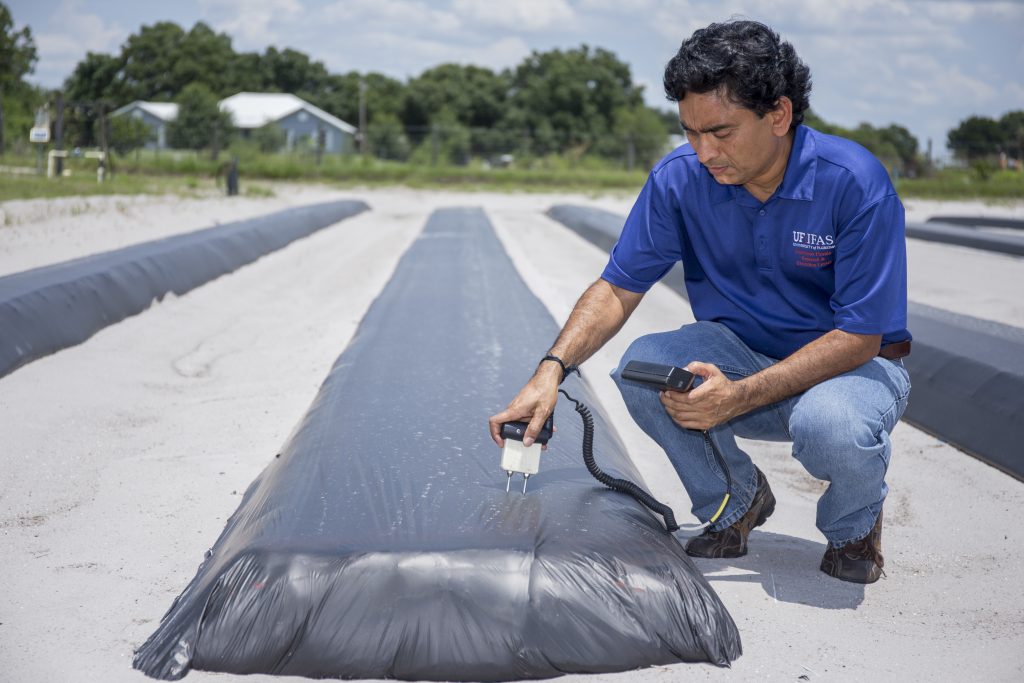
(UF/IFAS) — From Florida to Virginia, farmers are enjoying the fruits of Sanjay Shukla’s labor. His compact-bed geometry system allows growers to plant crops in tall soil beds, and the result is thousands of dollars in annual savings.
New research by Shukla and his team shows that with savings of up to $102,000 per crop, annually, for a typical, 250-acre farm from the compact-bed geometry, farmers can buy wireless soil-moisture meters to better manage water and crops.
“This benefit provides growers many options to invest the savings in other aspects of modernizing their farms,” said Shukla, a University of Florida Institute of Food and Agricultural Sciences (UF/IFAS) professor of agricultural and biological engineering. Those aspects include automated irrigation.
With soil-moisture meters, farmers can keep an eye on how they reduce water and fuel use. They can also help prevent fertilizer from getting into water bodies, Shukla said.
In the new study, Shukla’s team put data from their prior research into computer models. Their models showed that Shukla’s compact bedding design can save $20,020 to $102,570 per year for a typical fresh produce farm.
That’s because the combination of compact soil beds and soil-moisture irrigation can further reduce the amount of water and other inputs such as fuel and fertilizer.
Shukla’s raised soil beds, covered with plastic mulch, are almost 6 inches taller and 1 foot narrower than conventional soil beds most growers use to produce fruits and vegetables.
About six years ago, Shukla started designing raised beds – also called compact-bed geometry — that help reduce water, nutrients, pesticides, fuel and plastic, which are all needed to help grow tomatoes, peppers and other crops.
A few years ago, researchers studied raised beds on a commercial farm in Collier County, Florida, near the UF/IFAS Southwest Florida Research and Education Center (SWFREC) in Immokalee.
As the compact-bed geometry research continues, Shukla said plastic’s effect on runoff is akin to that of asphalt or concrete in a city. The more area it covers, the more rainwater runs off the plastic. It also can reduce runoff of nutrients, such as nitrogen and phosphorus, said Shukla, a faculty member at the UF/IFAS SWFREC. Reduced runoff helps cut nutrients to downstream environments such as lakes and rivers.
Meanwhile, Shukla and his colleagues are continuing to improve the raised-bed design for soils. For example, they’re evaluating whether compact beds can reduce pests and diseases that damage tomatoes and other crops. Early results show potential for less damage from plant-parasitic nematodes and better soil health. Preliminary findings also show promise in fighting plant pathogens such as Phytophthora and Fusarium.
Shukla’s colleagues include Johan Desaeger, assistant professor of entomology and nematology at the UF/IFAS Gulf Coast Research and Education Center as well as Sarah Strauss, a UF/IFAS assistant professor of soil microbiology and Pamela Roberts, a UF/IFAS plant pathology professor – both faculty members at the SWFREC.
Shukla and his team are now designing and testing compact beds for watermelon, which is different than other crops such as tomato, which is grown vertically.
Shukla’s new study on water conservation and cost savings is published in the Journal of Irrigation Drainage and Engineering.
Source: University of Florida Institute of Food and Agricultural Sciences









